The Beauty and Rarity of Peacock Pearls: A Comprehensive Guide

What if I told you that one of nature’s most precious and fascinating creatures could produce a rare and beautiful gemstone known as peacock pearls? These truly unique gems are created within the very anatomy of their hosts—peafowl! Would you believe it?
Yes, indeed – this science-meets-nature phenomenon actually exists. Peacock pearls have been inspiring awe since ancient times; however, many don’t know how these gorgeous jewels form or what makes them so special.

The coveted peacock pearl is a hue of the precious Tahitian saltwater pearls cultivated in Polynesia’s Pinctada margaritifera black-lipped oyster. Its highly desired color has made it one of the most sought-after gems worldwide.
As a jewelry expert, I am here to provide you with a comprehensive guide to the beauty and rarity of peacock pearls. So let’s dive in and discover why this gemstone is so valuable and what it takes to create these unique pearls!
What Is a Peacock Pearl?
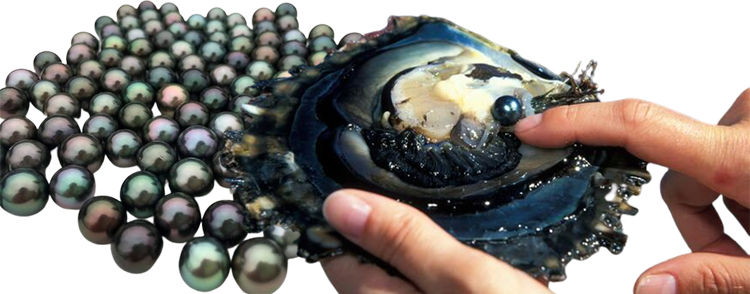
A peacock pearl is a stunning gemstone formed within the mollusk species Pinctada margaritifera, commonly known as the black-lipped oyster. These unique pearls are highly sought for their exceptional beauty and iridescent colors.
Physical Characteristics of Peacock Pearl

Peacock pearls, like other pearls, are composed of calcium carbonate in the form of aragonite and a protein called conchiolin.
The layers of aragonite and conchiolin are arranged in a concentric manner around an irritant, forming a pearl.
The organic structure of peacock pearls contributes to their durability. However, they are still relatively soft, with a 2.5 to 4.5 on the Mohs scale of mineral hardness. Thus, they should be treated with care to prevent damage.
Color and Luster of Peacock Pearl

The most distinctive feature of peacock pearls is their enchanting array of colors. While “peacock” may suggest a single hue, these pearls exhibit a mesmerizing blend of colors, including green, blue, gold, and purple.
The iridescence of peacock pearls results from the thickness and layering of the nacre, the substance that forms pearls.
The luster of peacock pearls refers to the quality and intensity of light reflected from their surface. High-quality peacock pearls possess a sharp and bright luster, which adds to their allure.
Factors that influence the luster of peacock pearls include the quality of the nacre, the cleanliness of the pearl’s surface, and the pearl’s overall shape.
Shape and Size of Peacock Pearl
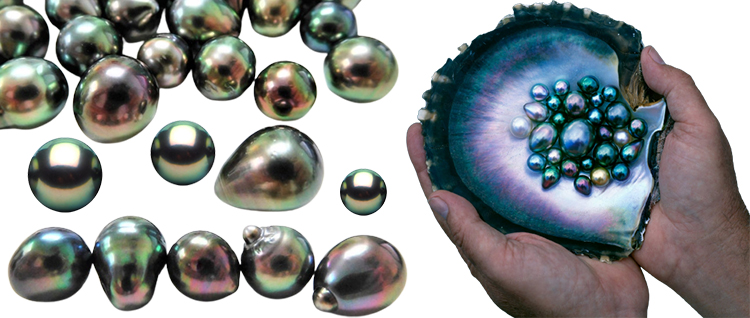
Peacock pearls come in various shapes, from perfectly round to semi-round, drop, baroque, and even button shapes.
Round pearls are considered the most valuable due to their rarity and aesthetic appeal. At the same time, other shapes can be equally intriguing and beautiful.
The shape of a peacock pearl is determined by the conditions under which it forms, as well as the position of the irritant within the mollusk.
The size of peacock pearls can vary significantly, typically ranging from 8mm to 18mm in diameter. Larger pearls are rarer and often more valuable. Still, the value of a peacock pearl also depends on its shape, color, and luster.
The size of a peacock pearl can be determined by various factors, including the size of the oyster, how long it has been cultivated, and the thickness of its nacre layers.
Where Are Peacock Pearls Found?
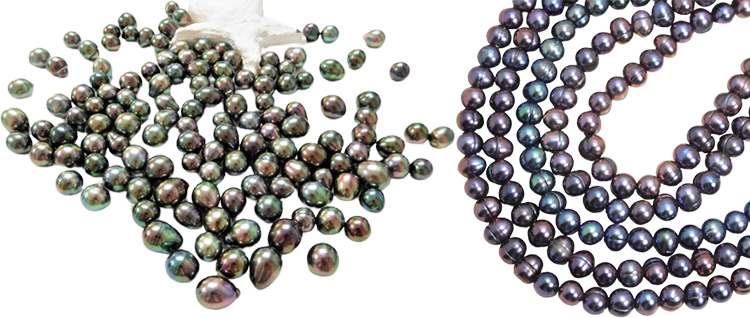
Scattered throughout many oceans and waterways, peacock pearls are largely harvested in China and Japan.
To cultivate peacock pearls, only the most pristine bodies of water with a high mineral content will suffice - think rivers, lakes, or other freshwater sources. These environments must be kept consistently clean and pure to support their growth.
To cultivate peacock pearls, the oysters must be kept in well-ventilated spots and shielded from extreme temperatures.
The environment for growing peacock pearls must be carefully monitored to ensure the best quality. For example, temperature fluctuations can affect the color of the pearl’s nacre, while the movement of contaminants through the water can lead to discoloration or blemishes on the surface of the pearl.
Another important factor is light: natural sunlight and artificial light must not come into contact with the oysters directly, as it can cause discoloration and damage their shells. Therefore, these special areas must have suitable lighting to accommodate these delicate organisms.
How Are Peacock Pearls Formed?

Peacock pearls are formed inside the black-lipped oyster, Pinctada margaritifera, native to the waters of French Polynesia, the Cook Islands, and the Micronesian region.
The Formation Process
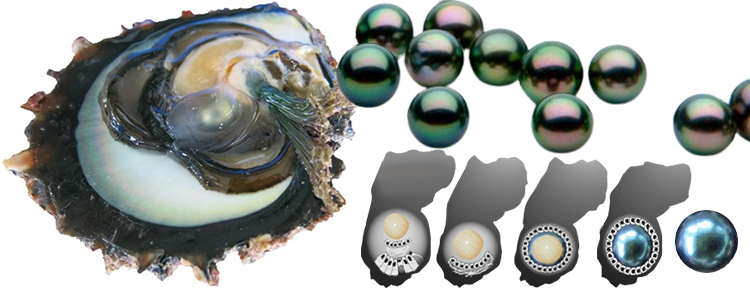
The formation process of peacock pearls is similar to that of other pearls, which involves the secretion of nacre by the mollusk around an irritant or nucleus.
The process begins when a small bead or nucleus, usually made of mother-of-pearl, is surgically implanted into the oyster’s gonad, along with a small piece of mantle tissue from another oyster.
This mantle tissue contains cells that secrete nacre, a lustrous substance made of calcium carbonate, and a protein called conchiolin. Over time, the oyster secretes layer upon layer of nacre around the nucleus, eventually forming the pearl.
The Role of the Mollusk in Peacock Pearl Formation

The black-lipped oyster, Pinctada margaritifera, plays a crucial role in forming peacock pearls. Its mantle tissue contains a unique blend of pigments that give the nacre its characteristic coloration.
The peacock pearl’s iridescent hues come from the interference, reflection, and refraction of light by the nacre layers. As a result, the color variations can range from green, blue, and purple to bronze, gray, and silver.
The thickness of the nacre layers is crucial to the pearl’s color and luster. Thicker layers typically result in richer colors and a more pronounced iridescence.
The oyster must remain healthy throughout the pearl formation process, which can take anywhere from 18 months to 3 years.
Factors that Influence the Quality of Peacock Pearls
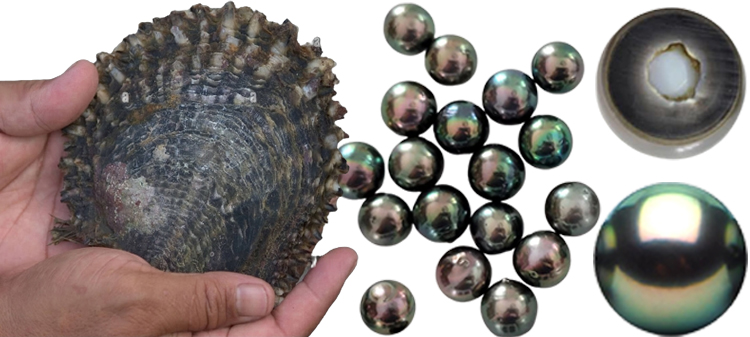
To determine the quality of peacock pearls, one must consider a few aspects, such as the oyster's physical characteristics and growth conditions. The highest-grade pearls are likely derived from a strong and healthy oyster.
Not only does size play a role in determining the value of a pearl, but its shape and thickness of the nacre layer can also influence how much it is worth.
Symmetrical pearls typically garner higher prices than those with less regular patterns. At the same time, thicker layers often display an enhanced luster and more vibrant colors - desirable attributes that add to their worth.
The value of a peacock pearl is also affected by its surface condition - pearls with no blemishes or discoloration are significantly more sought-after than those that do.
Finally, environmental conditions must also be taken into consideration: for a pearl to reach its full potential, it must be grown in a body of water with suitable temperature, chemistry, light levels, and circulation.
What Makes Peacock Pearls Valuable?

Peacock pearls are highly sought-after for their exceptional beauty, rarity, and unique qualities. These factors contribute to their value in the jewelry industry, as well as their appeal to collectors and enthusiasts alike.
Rarity and Uniqueness

The first factor that affects peacock pearls’ value is their rarity and uniqueness. Peacock pearls are a type of Tahitian pearl produced by the black-lip oyster (Pinctada margaritifera).
These oysters are primarily found in the waters surrounding French Polynesia and the Cook Islands, limiting their geographic distribution. As a result, the supply of peacock pearls is restricted, contributing to their rarity.
Furthermore, peacock pearls display a unique and captivating color, characterized by a dark base hue with an iridescent overlay of green, blue, and sometimes purple, which gives them their peacock-like appearance. This radiance, known as orient, arises from how light interacts with the microscopic layers of the nacre that compose the pearl.
High Demand from the Jewelry Industry
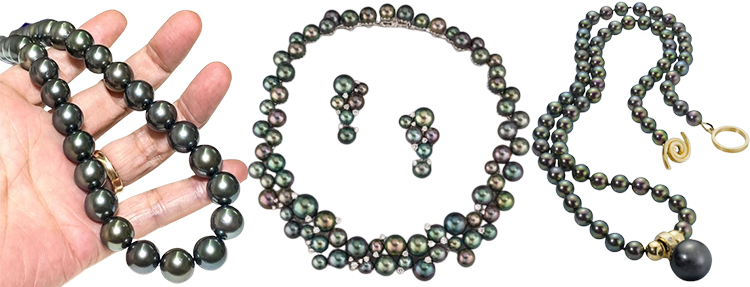
The second factor that affects peacock pearls’ value is the high demand from the jewelry industry. Demand for peacock pearls has been high among jewelry makers for years now due to their unique aesthetic and value.
As a result, these gems are often used in traditional and modern designs and have become increasingly popular among designers specializing in customized pieces.
Moreover, designers and jewelers appreciate peacock pearls for their versatility. The unique color palette of these pearls allows them to be incorporated into various styles and designs, from traditional to contemporary. This versatility further fuels the demand for peacock pearls in the jewelry industry.
Famous Peacock Pearl Jewelry Pieces
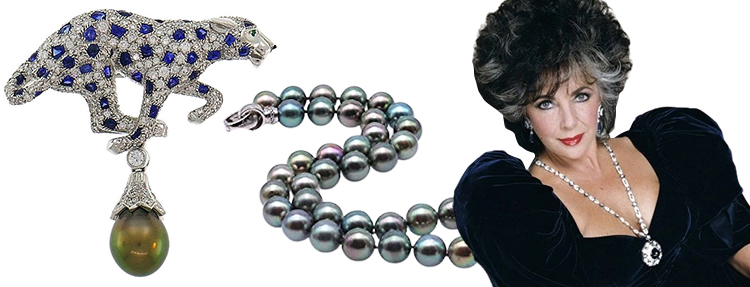
While there may not be specific, world-famous pieces solely dedicated to peacock pearls, these pearls have been utilized in many exquisite jewelry designs. High-end jewelers and luxury brands such as Cartier, Bvlgari, and Mikimoto have created remarkable peacock pearl pieces that showcase their beauty and elegance.
One example of a famous peacock pearl piece is the necklace worn by Elizabeth Taylor in National Velvet. This beautiful piece featured an emerald-cut diamond surrounded by four small diamonds set between two natural black Tahitian pearls, one being a peacock pearl.
Another famous example is the Cartier Art & Nature de Cartier High Jewelry necklace featuring a large round black Tahitian pearl accented with diamonds, rubies, and sapphires.
These famous pieces prove that peacock pearls can make any piece of jewelry truly stand out. They are a symbol of elegance and sophistication and will surely draw attention and admiration wherever they are worn.
Conclusion

Overall, peacock pearls are an incredible gem highly valued for their uniqueness, rarity, and beauty. Unfortunately, they are found in the waters of French Polynesia and the Cook Islands, making them geographically restricted.
With their vibrant color range and striking aesthetic, peacock pearls are highly coveted by jewelers across the industry. In fact, these gems have been featured in some of the most iconic jewelry pieces!
Boasting such unparalleled characteristics, it's no wonder why they're labeled a true treasure in the world of jewelry.
Peacock pearls are an eye-catching gem that will make your jewelry one of a kind. If you want to be the envy of any social event, these rare and mesmerizing beauties are definitely worth considering!


Leave a Comment